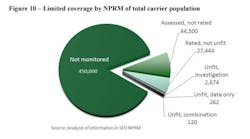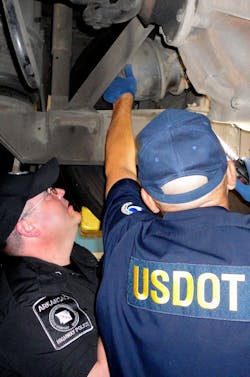Drop it: Safety fitness proposal ‘premature’ in eyes of trucking
The proposed change in the way the DOT rates carriers defies the will of Congress, is based on a flawed foundation, and simply doesn’t improve on the current system—that’s the trucking industry’s near-unanimous assessment, based on formal comments filed on the Safety Fitness Determination rulemaking docket.
The American Trucking Assns. sums up the opinions of its members and many others in its filing regarding the Federal Motor Carrier Safety Administration’s data-driven revision.
“ATA is strongly opposed to FMCSA’s Safety Fitness Determination (SFD) proposal and calls on the agency to rescind it,” ATA says. “Congress has clearly communicated its concerns about the reliability of Compliance, Safety, Accountability (CSA) Safety Measurement System (SMS) data in assessing the safety performance and crash risk of individual fleets. Proposing to use this same data to make SFDs with strong consequences (prohibitions on operating) is inappropriate.”
ATA goes on to encourage FMCSA to withdraw the proposal pending the CSA review and reform required by the FAST Act—and says that ATA “could possibly support a future proposal of this sort” only after the SMS data is made “reliably indicative of individual fleet safety performance.”
Indeed the concept—to base safety ratings primarily on performance data “rather than records scrutinized during on-site compliance reviews”—is one ATA has long supported, the comment notes. And while ATA “appreciates” the proposal’s attempt to address the data sufficiency problems identified in previous reviews of CSA, the 11-inspection threshold for a carrier assessment could “give rise to confusion,” namely that 425,000 of the 500,000 or so active carriers will not be assessed at all.
“This flaw in the system is troubling. The term ‘unfit’ is applied to fleets that, comparatively speaking, are considered the least safe in the industry,” ATA writes. “Yet FMCSA lacks sufficient data on 4/5ths of the industry to make such a determination.”
Similarly, the Truckload Carriers Assn. (TCA) emphasizes the importance of safety determinations, and that “it is imperative that the judgment of rendering a carrier as ‘unfit’ be based upon the most accurate information available to the agency.”
However, “the very fact that this rule would only determine the safety fitness of approximately 75,000 carriers is incomprehensible and discriminant to say the very least. As a result of this shortfall, TCA cannot possibly support a rule that creates an environment that is not equal to all involved and in many cases, allowing a competitive advantage of one carrier versus another.”
Additionally, TCA is concerned that the single rating implies “that if a carrier is not rated as ‘unfit’ then they are indeed ‘fit’ and/or safe to operate, when the exact opposite can be true.”
OOIDA points to the state-to-state variability in violation rates, and that the data does not allow for the accurate comparison of carriers. Additionally, much of that data “are simply allegations of violations reported by state and federal personnel from roadside inspections—allegations that drivers do not have the opportunity to challenge before an independent fact finder.”
OOIDA also notes the consequence of an “unfit” rating for a small trucking company.
“Procedurally, FMCSA must add pre-deprivation due process to the safety fitness determination process—an opportunity for a motor carrier to defend itself and demonstrate its safety before its reputation is ruined by an errant ‘unfit’ safety rating,” OOIDA writes. “Small businesses do not have the resources to survive several weeks or months without business while they attempt to appeal an unsafe rating.”
Transportation attorney Henry Seaton submitted comments on behalf of a coalition of eight trucking and freight transportation groups, including the Alliance for Safe, Efficient and Competitive Truck Transportation (ASECTT), National Association of Small Trucking Companies (NASTC), the Expedite Alliance of North America (TEANA), and the Western States Trucking Assn. (WSTA).
The filing calls the proposal “a test,” and questions whether FMCSA can proceed on numerous issues. The comment suggests the rulemaking “repurposes” the SMS with only “superficial changes” to a methodology “condemned by Congress and criticized in almost six years of independent statistical studies.” The data-laden comment also points to “proven disproportionate impacts that threaten the viability of smaller carriers” and “a state-by-state patchwork of inconsistent roadside inspection practices.”
And, based on an analysis of the “limited coverage” of the carrier population afforded under the proposal, “it is time to start all over and look at a different method of not only monitoring and policing motor carriers, but also assisting and working with all carriers to ensure compliance.”
Tim Wiseman, managing partner of the law firm Scopelitis, Garvin, Light, Hanson & Feary, submitted comments on behalf of 10 carriers, including U.S. Xpress Enterprises and Hirschbach Motor Lines. The coalition calls on FMCSA to withdraw the proposal, based on FAST Act concerns, and to “revisit SFDs at a later date.”
“Short of that, the proposed rule suffers from a number of defects, most notably those that deprive or diminish carriers’ constitutional due process rights,” Wiseman says.
The National Private Truck Council likewise calls the rulemaking “premature,” and says FMCSA has “no compelling reason” to move forward ahead before the CSA review is complete and corrections are implemented.
Individual carriers submitted comments as well, including several of the largest: Werner Enterprises, Schneider National, YRC Worldwide, CRST International, Knight Transportation, Universal Truckload, Roehl Transport, J.B. Hunt Transport, and Decker Truck Line.
Enforcement, freight brokers and highway safety groups were more generally supportive of the proposal, though they raised many of the same concerns—if not for the same reasons.
Luke warm, at best
The Commercial Vehicle Safety Alliance, representing North American regulatory enforcement agencies, is supportive of the rulemaking “overall” and says that while the peer percentages are useful in prioritizing carrier interventions, the use of “absolute” carrier inspection data is “appropriate” for a fitness assessment.
Likewise, CVSA says the incorporation of roadside inspection data, “provided FMCSA partners with state enforcement agencies to further enhance the quality and uniformity” will help assure that fitness determinations are more accurate and up to date than the current rating system, which relies on resource-intensive compliance reviews.
CVSA does question the absence of moving-violation data issued outside of a roadside inspection report, and encourages FMCSA to investigate the feasibility of incorporating those violation reports into the system. “It should be noted, however, that this data should only be incorporated if and when it can be done consistently and reliably, in all jurisdictions. CVSA opposes incorporation of this data on a piecemeal basis.”
The Transportation Intermediaries Assn., representing brokers, supports the rulemaking because the proposed new system “will drastically eliminate confusion and the potential liability traps, which continue to plague the 3PL industry.”
“As an industry that is made up of thousands of small businesses we need a single, clear cut safety standard from the FMCSA,” TIA comments. “It is imperative that this single-tiered rating system be maintained throughout this rulemaking process.”
But TIA also encourages FMCSA to work with the trucking industry and “take an open minded approach” to the FAST Act review. TIA continues to advocate that CSA “should be completely removed from public view, including violations and crash data.”
Even the U.S. Small Business Administration's (SBA) Office of Advocacy weighed in to report the concerns of small businesses, notably that “the proposed SFD methodology is flawed and the proposed rule will have a disproportionate impact on small carriers.”
Road Safe America supports the more simple, single rating system and the goal of assessing more carriers, but questions whether setting an “arbitrary” minimum of 11 inspections will result in small carriers being overlooked.
“Our understanding through colleague organizations is that your proposal will only address the bottom performing 1-4% of motor carriers. If we were talking about air travel, with their outstanding safety results, that would seem like a more than reasonable level of regulatory involvement,” co-founder Steve Owings writes. “However, heavy commercial vehicles are involved in crashes that result in roughly 4,000 deaths and 100,000 injuries each year, which can hardly be considered similar. We encourage the FMCSA to strongly consider methods of addressing a much larger percentage of the roadway-freight industry.”
Advocates for Highway and Auto Safety, while supporting the increased use of data within the SFD and the “unfit” designation, expressed concern that the proposal “is flawed in a number of important areas.” Specifically, the group questions the limited use of the Crash Indicator and suggests the 11-inspection minimum would greatly reduce the pool of rated carriers.
“Advocates is concerned that these artificially low criteria are not necessarily aimed at identifying and rooting out all unfit carriers. Rather, the change proposed by FMCSA appears to revise the definition of an unfit carrier in order to identify a smaller, more manageable number of unfit carriers to better conform to the agency’s available enforcement resources,” the comment states. “Simply changing the ‘unfit’ definition does not make previously unsafe carriers which do not now meet the new definition of ‘unfit’ any more safe than they were before.”
Similar comments were filed by the Truck Safety Coalition.
About the Author
Kevin Jones 1
Editor
Kevin has served as editor-in-chief of Trailer/Body Builders magazine since 2017—just the third editor in the magazine’s 60 years. He is also editorial director for Endeavor Business Media’s Commercial Vehicle group, which includes FleetOwner, Bulk Transporter, Refrigerated Transporter, American Trucker, and Fleet Maintenance magazines and websites.

